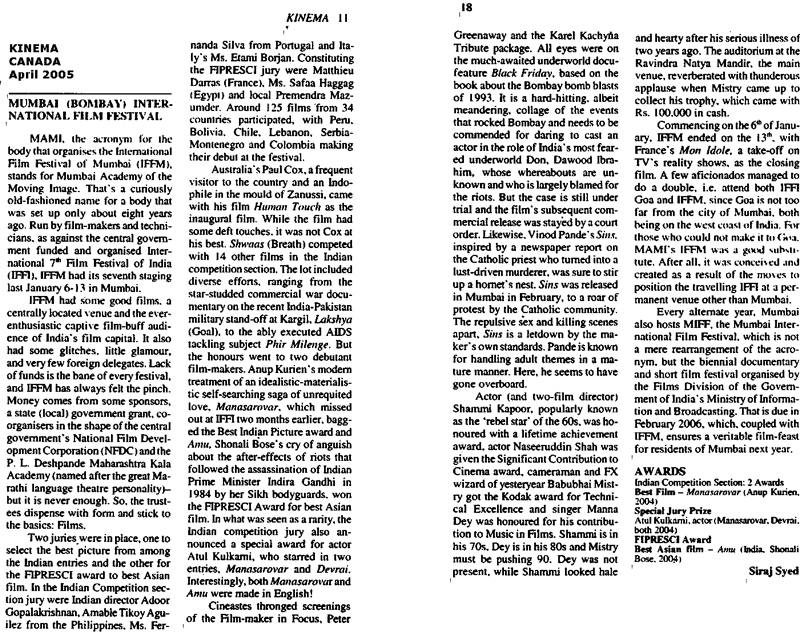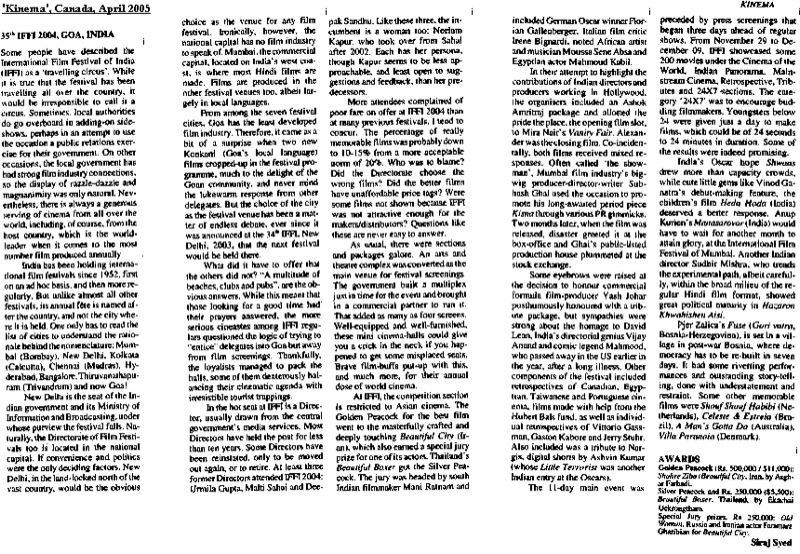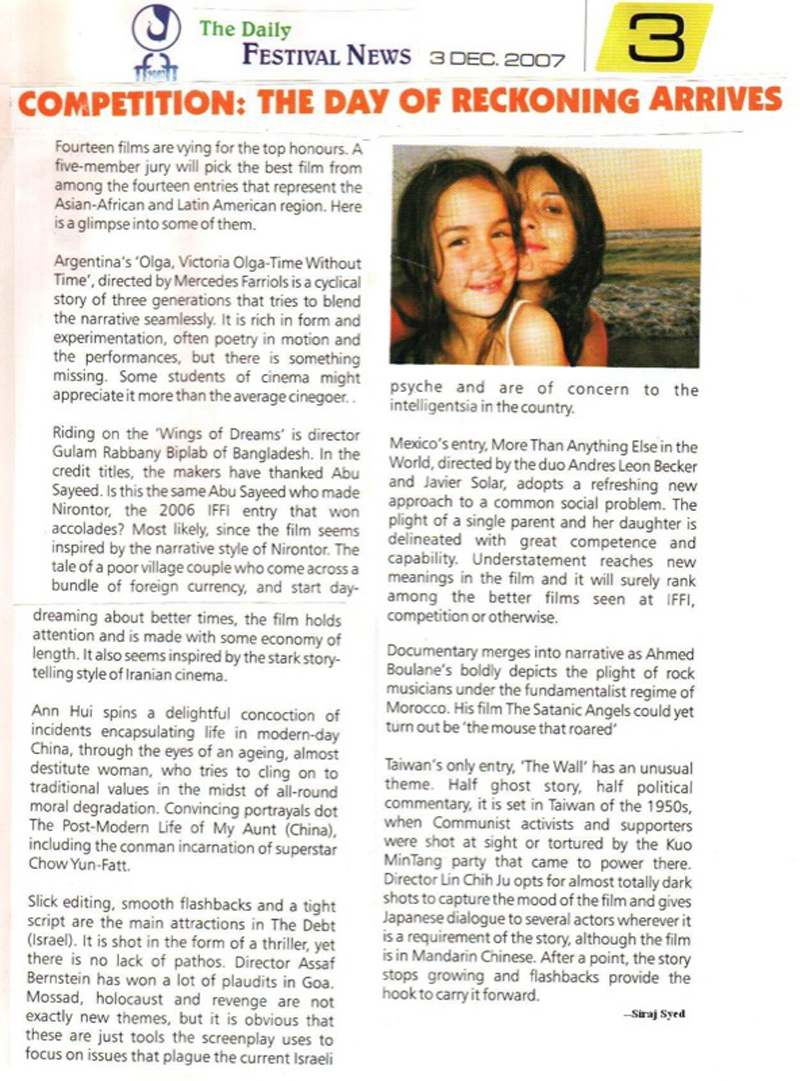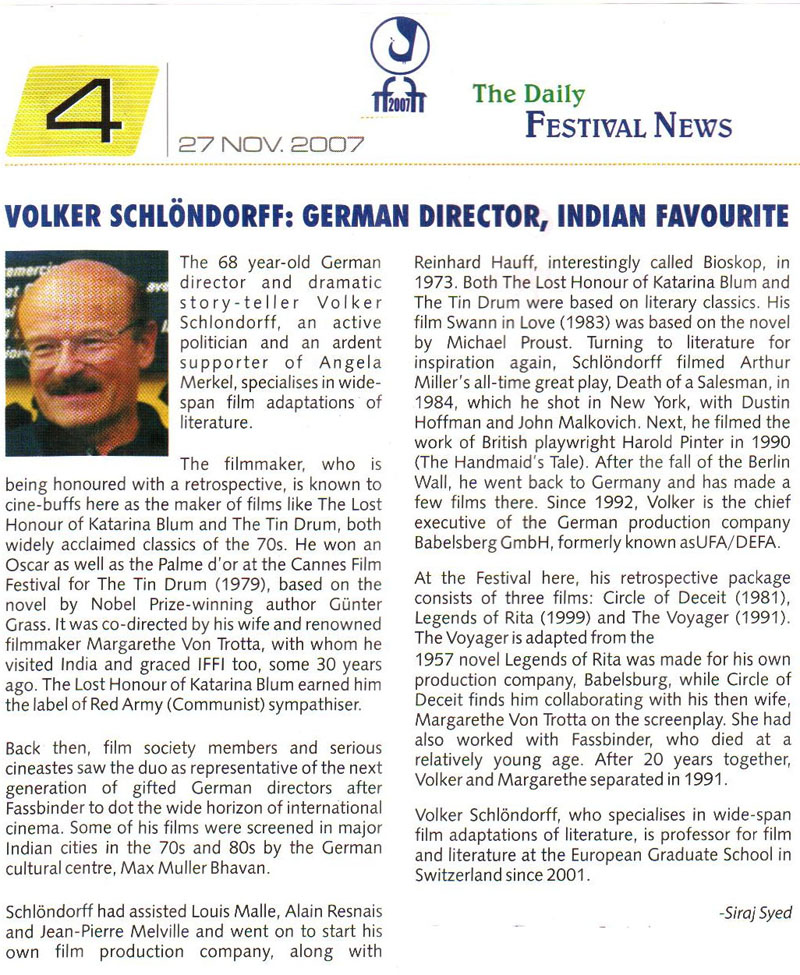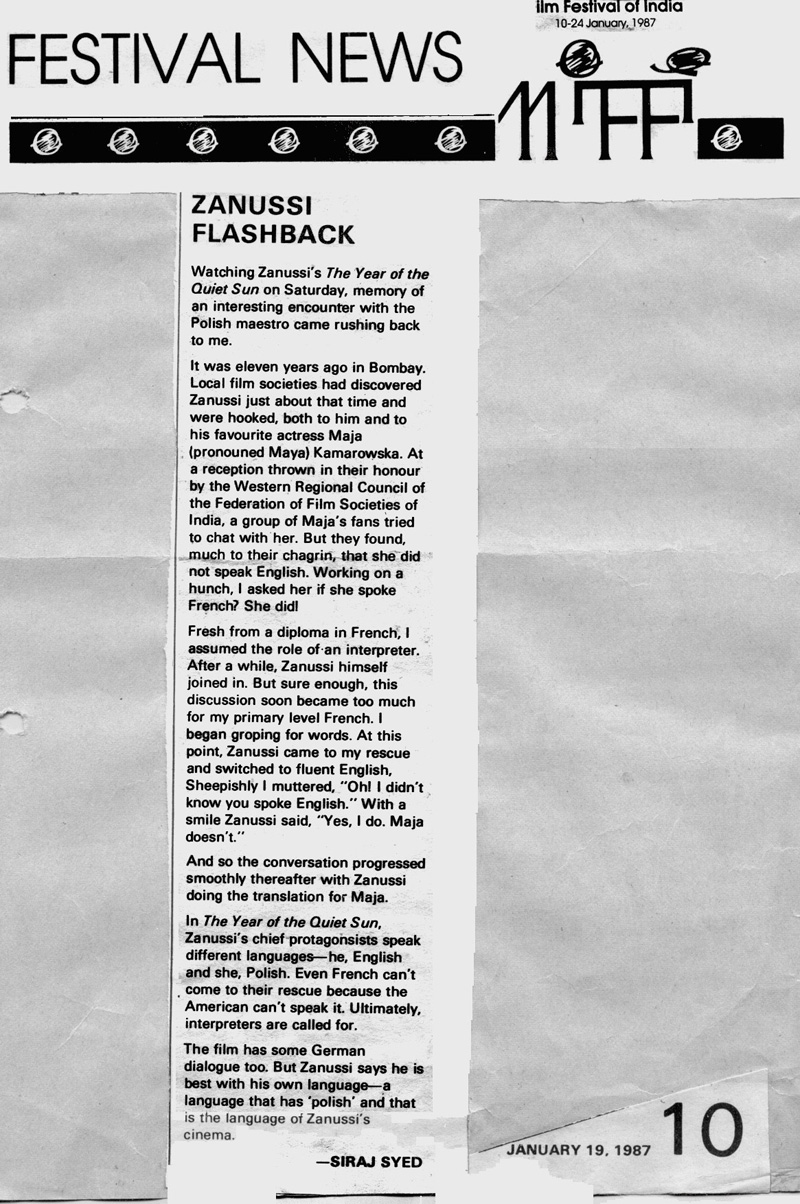|
|
||
|
Pro Tools
FILMFESTIVALS | 24/7 world wide coverageWelcome ! Enjoy the best of both worlds: Film & Festival News, exploring the best of the film festivals community. Launched in 1995, relentlessly connecting films to festivals, documenting and promoting festivals worldwide. Working on an upgrade soon. For collaboration, editorial contributions, or publicity, please send us an email here. User login |
Vikrant Rona, Review: Ducking in 3D
Vikrant Rona, Review: Ducking in 3D Exotic, lush green locales and serial killing do not go together, but here they do. Vikrant Rona is the name of the protagonist (or is it?), the second part of which, ‘rona’, means ‘crying’ in Hindustani. The ‘n’ is pronounced more harshly in the film, so it is not exactly ‘rona’ but roȠa (approximation). The makers decided to retain this name from the original Kannada, although it could have easily been changed, and dubbed, like the rest of the film. But I guess they wanted to cash in on the success of its Kannada original, released today, simultaneously, should that version hit box-office bulls-eye. Both the content and form of the film are different from many other films in the same genre, and there is a certain amount of novelty and style, yet Vikrant Rona falls far short of being anything like path-breaking. Located probably in the area around the Karnataka and Maharashtra border, a tropical rain forest is the setting for murder and mayhem. The film opens with a mother and daughter driving through, in pouring rain, and being preyed upon by mysterious forces. The girl disappears and we are not told what happens to the mother. There is a wedding in the offing at one of the houses in the village, owned by a big land-owner, who lives with his joint family. The son and his family arrive, to have the marriage solemnised at the old temple, which has been locked for 28 years. The patriarch of the family is upset with his son (it could be his brother, I am a bit confused) because firstly, he did not bother to visit the village for years, secondly, he wants to have the marriage in a temple that has been declared out-of-bounds due to a very dark history and thirdly, because the boy he has chosen for his daughter is not from the same caste. An Inspector of Police, posted in the village, has been murdered and decapitated. Taking advantage of this vacuum, a group of smugglers is trying to transport contraband goods on a ferry, while meting out capital punishment to someone who they accuse of being a police informer. Suddenly, they are beaten to pulp by a man who appears from nowhere. It is later conveyed that he is the replacement Police Inspector. He starts probing, opening files, questioning anyone and everyone. Metallic, arrow-like weapons are hurled at him at regular intervals, but none can harm Vikrant Rona. Yes, that is his name. He learns that one Moosa is the kingpin of the smugglers operating in the area under his jurisdiction, and to seek information about him, he visits his haunt, the giant pub run by Rakkamma. She tells him where to find him, and he finds and confronts Moosa, at the inter-state border, even as the two guards of the border check-post are killed. Is it the work of BrahmaRakshasa, or is are human minds behind the carnage? More deaths will occur, before the mystery is unravelled, or is it unravelled? This is the third venture of director Anup Bhandari (RangiTaranga, RajaRatha), who is multi-talented, if anything. He writes lyrics, sings, composes music and directs! Both his earlier films starred Nirup Bhandari and Avantika Shetty. Nirup Bhandari is in a major role in Vikrant Rona too. Now, match the phonetics, and you will find that Nirup is his brother. And his wife, Neetha Shetty, is the costume designer of all his films. Anup’s indirect association with Salman Khan began when he wrote lyrics for the Kannada version of Dabangg 3, three years ago. Salman is distributing the Hindi version of the film, and was present to promote the film and its song 'Ra ra Rakamma' a few days ago, in Mumbai. Now 40, Anup joined Infosys Technologies as a Software Engineer in Mysore, and eventually moved to USA, where he worked for almost a decade, before returning to India, to make his debut feature film. He has also written this film. As a screenplay, the film suffers from too many characters: the extended family of the land-owners, the Gambhiras, their prospective alliance’s family, police havaldars (constables), the old woman who ‘haunts’ the locked mandir, the smuggler, the PT teacher-cum-headmaster, the protagonist, his wife and daughter, dozens of school children and more. Perhaps his intention was to confuse and muddle the minds of the viewers, to create and retain suspense. He succeeds in this effort, only too well. After all the confusion and the muddling, there is not clear or enough unravelling. That is why it is supremely important not to create too many superfluous characters in the first place. Questioning his own logic, a character asks, “Have you ever seen a police officer who never wears his uniform and sports a beard?” That is what, exactly, Vikrant Rona does. He also tried to weave in all three major religions of India – Hinduism, Islam and Christianity – as part of the story. All major characters, naturally, are Hindu, but the PT teacher-cum-headmaster, Lawrence Pinto, is a Christian, apparently the only Christian in the entire village. He is particularly uncharitable to Islam. Two characters are Muslim – one a bumpkin named Faqhru who has fathered eleven children in 11 years and is a lookalike of his relative Moosa, and another the dreaded smuggler Moosa himself. Both were uncalled for. The caricature that that he makes of Faqhru is in bad taste, offensive, not funny. And what is it that Moosa smuggles that requires silencing of every possible informant and even passers-by, who might get a whiff (pun unintended) of his operations? It could be sandalwood (Karnataka is known for its sandalwood), but then why not say so, in so many words? Towards the climax, the director in Bhandari takes over from the writer, and we have a long-drawn battle at hand, with lots of gore, but very little by way of clarity about the mysterious killings. When a director is also the writer (story, screenplay and Kannada dialogue), there is always the danger that he will find it difficult to box-in the narrative within the confines of the duration of the film, which is a bit long, at 147 minutes. That seems to be the case here. In his attempt to create a super-hero without super-powers, just grit and gumption, and brute strength, the source of which is never explained, Bhandari side-tracks some of the basic elements of story-telling, like logic and novelty. The fires burning in the forest late at night, the weapons thrown at Vikrant and him ducking once too often, just in the ‘split second’ nick of time, the startling 3D effect notwithstanding, the various positions a being takes on, under and above a bed, Vikrant lighting a cigarette lighter to search for the body or belongings of the deceased Inspector, when what he needed was his powerful torch, the side-tracking of the narrative in bringing the girl back as a spirit, having Vikrant sing to her, her kiddy tales of her school-mate Bhaskar and her crusade against her father smoking, are distractions and pitfalls that could have been avoided. And the character of Rakkamma, replete with the erotic item song, is completely gratis and inconsequential. While building the persona of Vikrant, deciding the make-up and look, choosing the costumes, etc., Bhandari seems to have kept in mind the spaghetti Westerns of Sergio Leone and Phantom comics. Badshah Kichcha Sudeep, as he is billed in the titles, is full of swag and swagger. Too much of it. Attempts to show his soft, fatherly, side and a husband’s pain on a wife, all appear contrived. He is uncomfortable in the dance scenes, but outstanding in the climax fight. Nirup Bhandari as Sanjeev Gambhira, the ‘son’ who returns home after 28 years, does a routine job, and is effective in the light romance scenes. Neetha Ashok as Aparna Ballal is pleasing to the eye and looks really scared when asked to. Jacqueline Fernandez as Racquel ‘Rakkamma’ D’Costa leaves little to the imagination when she starts grooving, with her figure on the leaner side. Also in the cast, lending able support, are Vajradhar Jain as Lawrence Pinto, Kartik Rao Kordale as Faqhru/Pakru, Ravishankar Gowda as Vishwanath Ballal, Madhusudan Rao as Janardhan Gambhira, Vasuki Vaibhav as Baalu aka Baalakrishna, Siddu Moolimani as Munna aka Mohanchandra Ballal, Panna’s twin brother, Chitkala Biradar as Baby Ballal, Ramesh Kukkuvalli as Eknath Gambhira, whom Vikrant accuses of being the ring-leader, based on cryptic clues left behind by his predecessor, who had a penchant for scribbling coded clues on walls of the police station, and on pieces of paper. Most images are dark, better suited for 3D cinematography, which is by William David, who has gathered some impressive footage. The climax schedule was shot in picturesque Kerala, in December 2020. However, the 3D effect is impressive only once in a while. Ashik Kusugolli has edited the film well, with some jump-cuts and match cuts proving effective. But if the climax that was shot was a lengthier one, with lucid revelations, and if he has opted, instead, to show us the never-ending fights, I think he has made a mistake. Music has a character of its own, and often runs completely parallel to the visuals. Being a composer himself, Bhandari has reposed faith in Ajaneesh Loknath, who has risen to the occasion. If anything, the music should have been less ‘crowded’. ‘Ra ra Rakkamma’ is sure to get around. And the song with the children swinging from trees in baskets is a definite novelty. It must be stated that the Hindi dubbing is faulty, both in synchronisation and in translation. If, while seeing the film, you wonder why is there so much reference to Phantom, that is what the film was originally titled, Phantom. Maybe there were copyright issues, so the title was changed. Phantom was the first Kannada film to begin production work during the pandemic. It is co-produced by Kichcha Sudeep, who completes 25 years in films this year, Invenio Origin (which has a strong presence in the Middle East) and others. Vikrant Rona is genre bending – Phantom meets Clint Eastwood meets Steven Spielberg, in a completely Indian setting. But it is not likely to dent the psyche of cinema-goers much, who will feel that this was a classic case of an opportunity lost. There is a lot of searching and chasing in the film, but the search and chase to reach audiences hearts and minds might just prove elusive. Rating: ** ½ Trailer: https://www.youtube.com/watch?v=VV9SfpGRVFw 28.07.2022 | Siraj Syed's blog Cat. : 3D Ajaneesh Loknath Anup Bhandari Aparna Ballal Ashik Kusugolli Avantika Shetty Badshah Kichcha Sudeep Chitkala Biradar Christianity Clint Eastwood Dabangg 3 Hinduism Hindustani Invenio Origin islam Jacqueline Fernandez Kannada Kartik Rao Kordale Madhusudan Rao Neetha Shetty Nirup Bhandari Phantom Ra ra Rakamma RajaRatha Ramesh Kukkuvalli Ravishankar Gowda Salman Khan sandalwood sergio leone Siddu Moolimani Steven Spielberg Vajradhar Jain Vasuki Vaibhav William David Independent FILM
|
LinksThe Bulletin Board > The Bulletin Board Blog Following News Interview with EFM (Berlin) Director
Interview with IFTA Chairman (AFM)
Interview with Cannes Marche du Film Director
Filmfestivals.com dailies live coverage from > Live from India
Useful links for the indies: > Big files transfer
+ SUBSCRIBE to the weekly Newsletter Deals+ Special offers and discounts from filmfestivals.com Selected fun offers
> Bonus Casino
User imagesAbout Siraj Syed Syed Siraj Syed Siraj (Siraj Associates) Siraj Syed is a film-critic since 1970 and a Former President of the Freelance Film Journalists' Combine of India.He is the India Correspondent of FilmFestivals.com and a member of FIPRESCI, the international Federation of Film Critics, Munich, GermanySiraj Syed has contributed over 1,015 articles on cinema, international film festivals, conventions, exhibitions, etc., most recently, at IFFI (Goa), MIFF (Mumbai), MFF/MAMI (Mumbai) and CommunicAsia (Singapore). He often edits film festival daily bulletins.He is also an actor and a dubbing artiste. Further, he has been teaching media, acting and dubbing at over 30 institutes in India and Singapore, since 1984.View my profile Send me a message The EditorUser contributions |



















